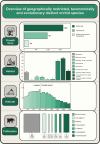Global conservation prioritization for the Orchidaceae
- PMID: 37185616
- PMCID: PMC10130154
- DOI: 10.1038/s41598-023-30177-y
Global conservation prioritization for the Orchidaceae
Abstract
Quantitative assessments of endemism, evolutionary distinctiveness and extinction threat underpin global conservation prioritization for well-studied taxa, such as birds, mammals, and amphibians. However, such information is unavailable for most of the world's taxa. This is the case for the Orchidaceae, a hyperdiverse and cosmopolitan family with incomplete phylogenetic and threat information. To define conservation priorities, we present a framework based on phylogenetic and taxonomic measures of distinctiveness and rarity based on the number of regions and the area of occupancy. For 25,434 orchid species with distribution data (89.3% of the Orchidaceae), we identify the Neotropics as hotspots for richness, New Guinea as a hotspot for evolutionary distinctiveness, and several islands that contain many rare and distinct species. Orchids have a similar proportion of monotypic genera as other Angiosperms, however, more taxonomically distinct orchid species are found in a single region. We identify 278 species in need of immediate conservation actions and find that more than 70% of these do not currently have an IUCN conservation assessment and are not protected in ex-situ collections at Botanical Gardens. Our study highlights locations and orchid species in urgent need of conservation and demonstrates a framework that can be applied to other data-deficient taxa.
© 2023. The Author(s).
Conflict of interest statement
The authors declare no competing interests.
Figures





References
-
- Faith DP. Conservation evaluation and phylogenetic diversity. Biology. 1992;61:1–10.
Publication types
MeSH terms
LinkOut - more resources
Full Text Sources

